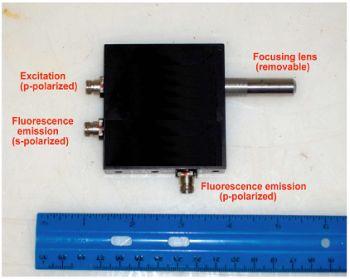Polarization Probe![]()
 The
polarization probe has two polarization channels which enable polarization
Raman spectra to be acquired. Polarization Raman uses polarized laser
excitation and polarization filters in each of two collection fibers with
the polarization filter in one fiber oriented parallel to the polarized
excitation laser and the polarization filter in the other fiber oriented
perpendicular to the polarized excitation laser. The resulting spectral
information gives an insight into molecular orientation and vibrational
symmetry. It is used to understand the orientation of molecules in organized
environments such as crystal lattices.
The
polarization probe has two polarization channels which enable polarization
Raman spectra to be acquired. Polarization Raman uses polarized laser
excitation and polarization filters in each of two collection fibers with
the polarization filter in one fiber oriented parallel to the polarized
excitation laser and the polarization filter in the other fiber oriented
perpendicular to the polarized excitation laser. The resulting spectral
information gives an insight into molecular orientation and vibrational
symmetry. It is used to understand the orientation of molecules in organized
environments such as crystal lattices.
Features and Specifications
| Spectral Range | 200 - 3900 cm-1 (Stokes)* |
| Excitation Wavelengths | 514, 532, 632, 670, "785" (782-788), 830 nm (laser must be +/- 1.5 nm of specified wavelength, except for 785 nm version) |
| Working Distance | 7.5 mm (std.), 5 or 10 mm optional |
| Fiber Configuration |
Permanently-aligned combination of two single fibers (105 µm excitation fiber, 200 µm collection fiber standard) with filtering and steering micro-optics, N.A. 0.22, in rugged polyurethane jacket. |
| Filter Efficiency | Patented design for complete filtering of the laser line and quartz spectral contributions from both input and output fibers (O.D. > 6 at laser wavelength) |
| Physical Resistance |
Durable probe can be used up to 80ºC |
| Cable Length | 1.5 m |
| Safety Features | Manual safety shutter† to block laser output; Class I sample holders available |
| Coupling System | Available with FC (std.) or SMA 905 connectors |
| Retail Price | call |
*Ultimate spectral
range will depend upon spectrograph and detector.
†U.S.
patent 6,621,574
Prices and specifications subject to change without notice.
All
information and images contained in this web site are Copyright ©
1998-2012 InPhotonics, Inc. All rights reserved.
